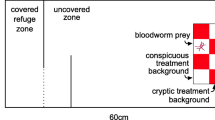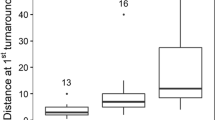Abstract
Individual variation in the behavior of prey can influence predation risk in complex ways. We ran individual roach (Rutilus rutilus), a common freshwater fish, through a standard refuge emergence protocol to characterize their boldness, a key animal personality trait. We then paired a bold and a shy roach and exposed the pair to one of two predator species that have contrasting hunting modes to ascertain how personality traits shaped their survival during predator encounters. When a paired bold and shy prey fish interacted with a perch predator (active foraging mode), bold and shy prey were consumed in almost equal numbers. However, pike predators (ambush foraging mode) selectively consumed more shy prey, and prey body size and boldness score both contributed significantly to which prey fish was eaten. Our findings support the idea that multiple predators with different foraging modes, and hence differential selection on prey personality, could contribute to maintaining variation in personality in prey populations. Furthermore, for social species, including shoaling fish, the ultimate consequences of an individual’s personality may depend upon the personality of its nearby conspecifics.
Significance statement
Animals of the same species often look similar, but individuals show differences in their behavior that can have important consequences, for instance when these individuals interact with predators. The common roach is a freshwater fish that shows inter-individual variation in its propensity to take risks, a key personality trait often termed boldness. Variation in boldness may affect the outcome when roach interact with predators, i.e., if they get eaten or survive. However, we found the impact of roachs’ personality type depends on what species of predatory fish they face. When we put a shy and a bold roach together with predatory perch, the roachs’ personality did not significantly affect which individual was eaten. But when the predator was a pike, the predators selectively ate more shy roach, and the likelihood an individual would be eaten depended on their body size.



Similar content being viewed by others
References
Bell AM, Sih A (2007) Exposure to predation generates personality in threespined sticklebacks (Gasterosteus aculeatus). Ecol Lett 10:828–834
Bell AM, Stamps JA (2004) Development of behavioural differences between individuals and populations of sticklebacks, Gasterosteus aculeatus. Anim Behav 68:1339–1348
Biro PA, Abrahams MV, Post JR, Parkinson EA (2004) Predators select against high growth rates and risk-taking behaviour in domestic trout populations. Proc R Soc Lond B 271:2233–2237
Blake CA, Gabor CR (2014) Effect of prey personality depends on predator species. Behav Ecol 25:871–877
Bond AB, Kamil AC (2002) Visual predators select for crypticity and polymorphism in virtual prey. Nature 415:609–613
Briffa M, Rundle SD, Fryer A (2008) Comparing the strength of behavioural plasticity and consistency across situations: animal personalities in the hermit crab Pagurus bernhardus. Proc R Soc Lond B 275:1305–1311
Brown C, Jones F, Braithwaite V (2005) In situ examination of boldness–shyness traits in the tropical poeciliid, Brachyraphis episcopi. Anim Behav 70:1003–1009
Chapman BB, Hulthen K, Blomqvist DR, Hansson LA, Nilsson JA, Brodersen J, Nilsson PA, Skov C, Brönmark C (2011) To boldly go: individual differences in boldness influence migratory tendency. Ecol Lett 14:871–876
Conrad JL, Weinersmith KL, Brodin T, Saltz JB, Sih A (2011) Behavioural syndromes in fishes: a review with implications for ecology and fisheries management. J Fish Biol 78:395–435
Cote J, Fogarty S, Sih A (2012) Individual sociability and choosiness between shoal types. Anim Behav 83:1469–1476
Dingemanse NJ, Both C, van Noordwijk AJ, Rutten AL, Drent PJ (2003) Natal dispersal and personalities in great tits (Parus major). Proc R Soc Lond B 270:741–747
Eklöv P, Werner EE (2000) Multiple predator effects on size-dependent behavior and mortality of two species of anuran larvae. Oikos 88:250–258
Gliwicz ZM, Szymanska E, Wrzosek D (2010) Body size distribution in Daphnia populations as an effect of prey selectivity by planktivorous fish. Hydrobiologia 643:5–19
Hart PJB (1997) Foraging tactics. In: Godin J-GJ (ed) Behavioural ecology of teleost fishes. Oxford University Press, Oxford, pp 104–133
Hulthén K (2014) Causes and consequences of individual variation in anti-predator traits. PhD-thesis, Lund University, Lund, Sweden
Hulthén K, Chapman BB, Nilsson PA, Hansson L-A, Skov C, Brodersen J, Vinterstare J, Brönmark C (2017) A predation cost to bold fish in the wild. Sci Rep 7:1239
Keiser CN, Modlmeier AP, Singh N, Jones DK, Pruitt JN (2014) Exploring how a shift in the physical environment shapes individual and group behavior across two social contexts. Ethology 120:825–833
Kortet R, Hedrick AV, Vainikka A (2010) Parasitism, predation and the evolution of animal personalities. Ecol Lett 13:1449–1458
Krause J, Butlin RK, Peuhkuri N, Pritchard VL (2000) The social organization of fish shoals: a test of the predictive power of laboratory experiments for the field. Biol Rev 75:477–501
Losey JE, Ives AR, Harmon J, Ballantyne F, Brown C (1997) A polymorphism maintained by opposite patterns of parasitism and predation. Nature 388:269–272
McPeek MA (2017) The ecological dynamics of natural selection: traits and the coevolution of community structure. Am Nat 189:E91–E117
Merilaita S (2006) Frequency-dependent predation and maintenance of prey polymorphism. J Evol Biol 19:2022–2030
Pruitt JN, Riechert SE (2011) How within-group behavioural variation and task efficiency enhance fitness in a social group. Proc R Soc Lond B 278:1209–1215
Pruitt JN, Stachowicz JJ, Sih A (2012) Behavioral types of predator and prey jointly determine prey survival: potential implications for the maintenance of within-species behavioral variation. Am Nat 179:217–227
Quinn JL, Cresswell W (2005) Personality, anti-predation behaviour and behavioural plasticity in the chaffinch Fringilla coelebs. Behaviour 142:1377–1402
Réale D, Reader SM, Sol D, McDougall PT, Dingemanse NJ (2007) Integrating animal temperament within ecology and evolution. Biol Rev 82:291–318
Rodgers GM, Downing B, Morrell LJ (2015) Prey body size mediates the predation risk associated with being “odd”. Behav Ecol 26:242–246
Royaute R, Pruitt JN (2015) Varying predator personalities generates contrasting prey communities in an agroecosystem. Ecology 96:2902–2911
Rudolf VHW, Rasmussen NL (2013) Ontogenetic functional diversity: size structure of a keystone predator drives functioning of a complex ecosystem. Ecology 94:1046–1056
Schreiber SJ, Buerger R, Bolnick DI (2011) The community effects of phenotypic and genetic variation within a predator population. Ecology 92:1582–1593
Schuett W, Tregenza T, Dall SRX (2010) Sexual selection and animal personality. Biol Rev 85:217–246
Sih A, Del Giudice M (2012) Linking behavioural syndromes and cognition: a behavioural ecology perspective. Phil Trans R Soc B 367:2762–2772
Sih A, Bell A, Johnson JC (2004) Behavioral syndromes: an ecological and evolutionary overview. Trends Ecol Evol 19:372–378
Smith BR, Blumstein DT (2008) Fitness consequences of personality: a meta-analysis. Behav Ecol 19:448–455
Smith BR, Blumstein DT (2010) Behavioral types as predictors of survival in Trinidadian guppies (Poecilia reticulata). Behav Ecol 21:919–926
Sogard SM (1997) Size-selective mortality in the juvenile stage of teleost fishes: a review. B Mar Sci 60:1129–1157
Stamps JA (2007) Growth-mortality tradeoffs and “personal traits” in animals. Ecol Lett 10:355–363
Swaegers J, Strobbe F, McPeek MA, Stoks R (2017) Selection on escape performance during ecological speciation driven by predation. Anim Behav 124:153–159
terHorst C, Lau J, Cooper I, Keller K, La Rosa R, Royer A, Schultheis E, Suwa T, JK C (2015) Quantifying nonadditive selection caused by indirect ecological effects. Ecology 96:2360–2369
terHorst CP, Zee PC, Heath KD, Miller TE, Pastore AI, Patel S, Schreiber SJ, Wade MJ, Walsh MR (2018) Evolution in a community context: trait responses to multiple species interactions. Am Nat 191:368–380
Torres-Dowdall J, Machado-Schiaffino G, Kautt AF, Kusche H, Meyer A (2014) Differential predation on the two colour morphs of Nicaraguan Crater lake Midas cichlid fish: implications for the maintenance of its gold-dark polymorphism. Biol J Linn Soc 112:123–131
Turesson H, Bronmark C (2004) Foraging behaviour and capture success in perch, pikeperch and pike and the effects of prey density. J Fish Biol 65:363–375
Van Buskirk J (2001) Specific induced responses to different predator species in anuran larvae. J Evol Biol 14:482–489
Van Buskirk J, Yurewicz K (1998) Effects of predators on prey growth rate: relative contributions of thinning and reduced activity. Oikos 82:20–28
Ward AJW, Thomas P, Hart PJB, Krause J (2004) Correlates of boldness in three-spined sticklebacks (Gasterosteus aculeatus). Behav Ecol Sociobiol 55:561–568
Webster MM, Ward AJW (2011) Personality and social context. Biol Rev 86:759–773
Werner EE, Anholt BR (1993) Ecological consequences of the trade-off between growth and mortality-rates mediated by foraging activity. Am Nat 142:242–272
Wey TW, Chang AT, Montiglio P-O, Fogarty S, Sih A (2015) Linking short-term behavior and personalities to feeding and mating rates in female water striders. Behav Ecol 26:1196–1202
Wilson ADM, McLaughlin RL (2007) Behavioural syndromes in brook charr, Salvelinus fontinalis: prey-search in the field corresponds with space use in novel laboratory situations. Anim Behav 74:689–698
Wilson DS, Coleman K, Clark AB, Biederman L (1993) Shy bold continuum in pumpkinseed sunfish (Lepomis gibbosus): an ecological study of a psychological trait. J Comp Psychol 107:250–260
Wolf M, Weissing FJ (2012) Animal personalities: consequences for ecology and evolution. Trends Ecol Evol 27:452–461
Acknowledgments
We thank Lars-Anders Hansson for participating in preparing the grant application and developing research ideas. We thank Marek Šmejkal and Jerker Vinterstare for help with field work and methodology. We acknowledge Caitlin Gabor for her mentorship of C.A. Blake, and Augustyn Blake for his continued support. We are grateful to the entire Aquatic Ecology Unit at Lund University for their feedback on the project. Finally, we thank two anonymous reviewers and the editor, whose suggestions helped us greatly improve the manuscript.
Funding
We thank the National Science Foundation for providing a grant through Graduate Research Opportunities Worldwide to C.A. Blake to support travel and supplies for collaborative research at Lund University.
Author information
Authors and Affiliations
Corresponding author
Ethics declarations
Ethical approval
All applicable international, national, and/or institutional guidelines for the care and use of animals were followed. All procedures performed in studies involving animals were in accordance with the ethical standards of the institution or practice at which the studies were conducted. Experiments were performed under permission from the Lund/Malmö Ethical Committee (permission number M36-14).
Conflict of interest
The authors declare that they have no conflict of interest.
Additional information
Communicated by J. Lindström
Rights and permissions
About this article
Cite this article
Blake, C.A., Andersson, M.L., Hulthén, K. et al. Conspecific boldness and predator species determine predation-risk consequences of prey personality. Behav Ecol Sociobiol 72, 133 (2018). https://doi.org/10.1007/s00265-018-2544-0
Received:
Revised:
Accepted:
Published:
DOI: https://doi.org/10.1007/s00265-018-2544-0




